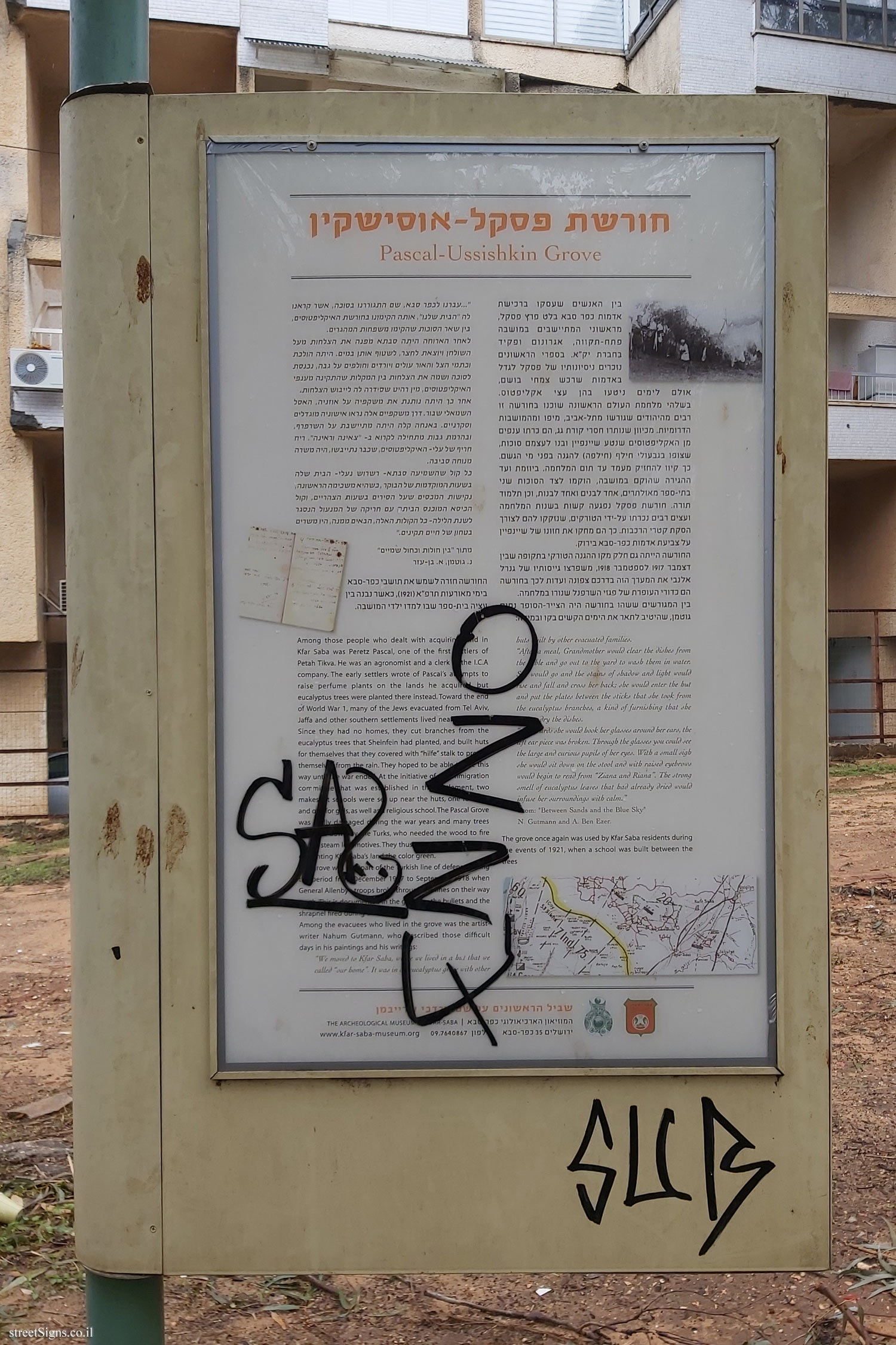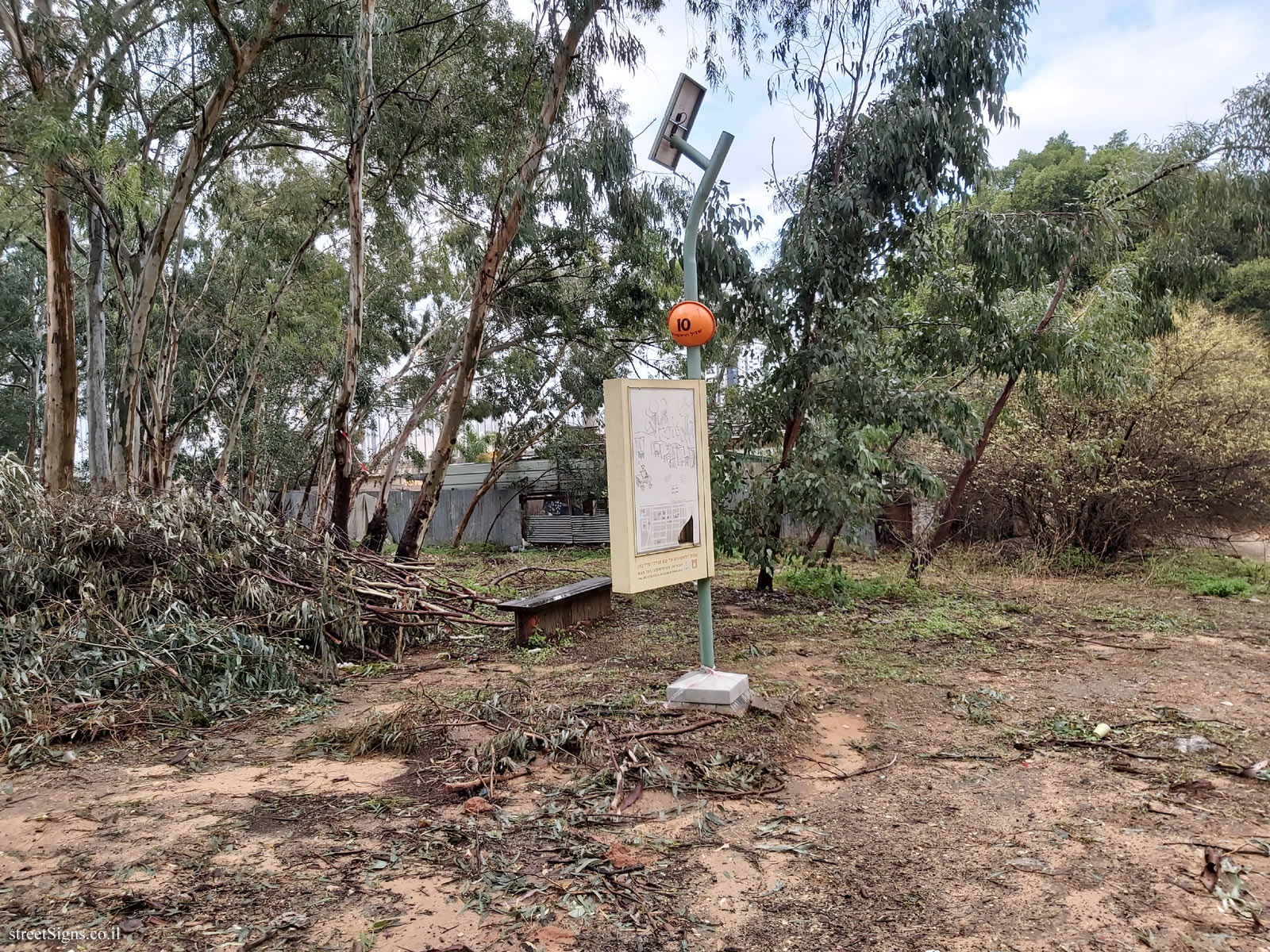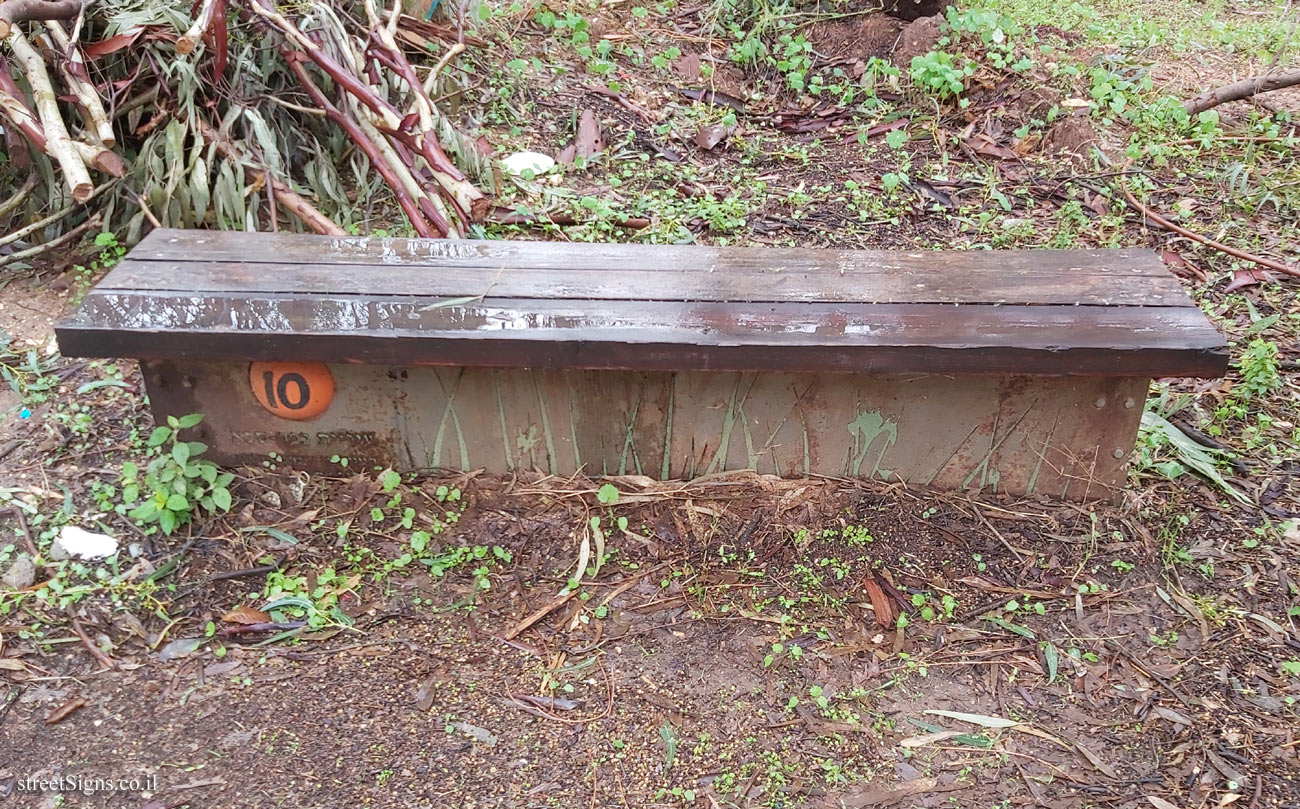On the sign:
[תמונה: ציור של נחום גוטמן]
[מפת השביל]
[הצד השני של השלט]
חורשת פסקאל - אוסישקין
Pascal-Ussishkin Grove
בין האנשים שעסקו ברכישת אדמות כפר סבא בלט פרץ פסקל, מראשוני המתיישבים במושבה פתח-תקווה, אגרונום ופקיד בחברת יק"א. בספרי הראשונים נזכרים ניסיונותיו של פסקל לגדל באדמות שרכש צמחי בושם, אולם לימים ניטעו בהן עצי אקליפטוס. בשלהי מלחמת העולם הראשונה שוכנו בחורשה זו רבים מהיהודים שגורשו מתל-אביב, מיפו ומהמושבות הדרומיות. מכיוון שנותרו חסרי קורת גג, הם כרתו ענפים מן האקליפטוסים שנטע שיינפיין ובנו לעצמם סוכות, שצופו בגבעולי חילף (חילפה) להגנה מפני מי הגשם. כך קיוו להחזיק מעמד עד תום המלחמה. ביוזמת ועד ההגירה שהוקם במושבה, הוקמו לצד הסוכות שני בתי-ספר מאולתרים, אחד לבנים ואחד לבנות, וכן תלמוד תורה. חורשת פסקל נפגעה קשות בשנות המלחמה ועצים רבים נכרתו על-ידי הטורקים, שנזקקו להם לצורך הסקת קטרי הרכבות. כך הם מחקו את חזונו של שיינפיין על צביעת אדמות כפר-סבא בירוק.
החורשה הייתה גם חלק מקו ההגנה הטורקי בתקופה שבין דצמבר 1917 לספטמבר 1918, משפרצו גייסותיו של גנרל אלנבי את המערך הזה בדרכם צפונה ועדות לכך בחורשה הם כדורי העופרת של פגזי השרפנל שנורו במלחמה.
בין המגורשים ששהו בחורשה היה הצייר-הסופר נחום גוטמן, שהיטיב לתאר את הימים הקשים בקו ובמילה:
"...עברנו לכפר סבא, שם התגוררנו בסוכה, אשר קראנו לה "הבית שלנו", אותה הקימונו בחורשת האיקליפטוסים, בין שאר הסוכות שהקימו משפחות המהגרים.
לאחר הארוחה היתה סבתא מפנה את הצלחות מעל השולחן ויוצאת לחצר, לשטוף אותן במים. היתה הולכת וכתמי הצל והאור עולים ויורדים וחולפים על גבה, נכנסת לסוכה ושמה את הצלחות בין המקלות שהתקינה מענפי האיקליפטוסים, מין רהיט שסידרה לה לייבוש הצלחות.
אחר כך היתה נותנת את משקפיה על אוזניה, האסל השמאלי שבור. דרך משקפיים אלה נראו אישוניה מוגדלים וסקרניים. באנחה קלה היתה מתיישבת על השרפרף, ובהרמת גבות מתחילה לקרוא ב- "צאינה וראינה". ריח חריף של עלי-האיקליפטוסים, שכבר נתייבשו, היה משרה מנוחה סביבה.
כל קול שהשמיעה סבתא - רשרוש נעלי-הבית שלה בשעות המוקדמות של הבוקר, כשהיא משכימה הראשונה, נקישות המכסים שעל הסירים בשעות הצהריים, וקול הכיסא המוכנס הביתה עם חריקה של המנעול הנסגר לשנת הלילה - כל הקולות האלה, הבאים ממנה, היו משרים בטחון של חיים תקינים."
מתוך "בין חולות וכחול שמיים"
נ. גוטמן, א. בן-עזר
החורשה חזרה לשמש את תושבי כפר-סבא בימי מאורעות תרפ"א (1921) כאשר נבנה בין עציה בית-ספר שבו למדו ילדי המושבה.
Among those people who dealt with acquiring land in Kfar Saba was Peretz Pascal, one of the first settlers of Petah Tikva. He was an agronomist and a clerk in the I.C.A company. The early settlers wrote of Pascal’s attempts to raise perfume plants on the lands he acquired but eucalyptus trees were planted there instead. Toward the end of World War 1, many of the Jews evacuated from Tel Aviv, Jaffa and other southern settlements lived near.
Since they had no homes, they cut branches from the eucalyptus trees that Sheinfein had planted, and built huts for themselves that they covered with "hilfe" stalk to protect themselves from the rain. They hoped to be able to stay this way until the war ended. At the initiative of immigration committee that was established in the settlement, two makes schools were set up near the huts, one for boys and one for girls, as well as a religious school. The Pascal Grove was totally damaged during the war years and many trees were cut by the Turks, who needed the wood to fire their steam locomotives. Thus they erased Sheinfein’s vision of coloring Kfar Saba’s land the color green.
The grove was part of the Turkish line.of defense during the period from December 1917 to September 1918 when General Allenby’s troops broke through the lines on their way north. This is documented in the lid bullets and the shrapnel fired during the war.
Among the evacuees who lived in the grove was the artist writer Nahum Gutmann, who described those difficult days in his paintings and his writings:
"We moved to Kfar Sava, where we lived in a hut that we called "our home". It was in eucalyptus grove with other huts built by other evacuated families.
"After a meal, Grandmother would clear the dishes from the table and go out to the yard to wash them in water. She would go and the stains of shadow and light would rise and fall and cross ber back; she would enter the hut and put the plates between the sticks that she took from the eucalyptus branches, a kind of furnishing that she use to dry the dishes.
"Afterwards she would hook her glasses around hber ears, the left ear piece was broken. Through the glasses you could see the large and curious pupils of her eyes. With a small sigh she would sit down on the stool and with raised eyebrows would begin to read from "Ziana and Riana". The strong smell of eucalyptus leaves that had already dried would infuse her surroundings with calm,"
From: "Between Sands and the Blue Sky"
N. Gutmaon and A. Ben Ezer.
The grove once again was used by Kfar Saba residents during the events of 1921, when a school was built between the trees
סמל העיר כפר סבא
סמל מוזיאון כפר סבא
שביל הראשונים על שם מרדכי שרייבמן
המוזיאון הארכיאולוגי כפר-סבא
ירושלים 35 כפר-סבא
טלפון 09.7640867
THE ARCHAEOLOGICAL MUSEUM OF KFAR-SABA
www.kfar-saba-museum.org

 Click for a larger image
Click for a larger image  Click for a larger image
Click for a larger image  Click for a larger image
Click for a larger image  Click for sign's details
Click for sign's details